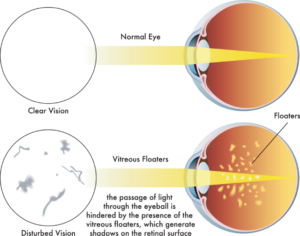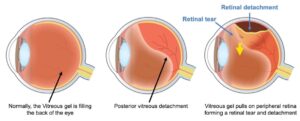Your cataract surgery may have gone perfectly, with a major improvement in your vision, however, you may be seeing particles in your vision, called floaters. Often people describe them as threads, cobwebs, or mosquitoes in their vision. While floaters after cataract surgery are common and usually do not cause any problems, sometimes, they can be a sign of a serious issue. In this article, we will discuss why floaters occur when they’re something to worry about, and what you can do about them.
What Exactly Do Floaters Look Like
Floaters look like faint grey or black particles and strands in your vision, and are most commonly seen when looking at a plain background in bright lighting such as the sky outdoors or a computer screen.
People often describe floaters as looking like:
- Threads
- Lines
- Cobwebs
- Strings of beads
- Flying bugs or mosquitoes
- Dots
- Semi circular or circular rings
They move around inside the eye and so it is difficult to look at them directly as they change position with eye movements.
Why Do We See Floaters?
The back of our eye is filled with a gel like substance called the vitreous. It is made of a network of threads (collagen) and a few scattered cells, held together by a glue like substance (glycosaminoglycans). As we age, the glue like part of the vitreous liquefies, and the collagen and cells come together and start to clump up.
Light needs to pass through the vitreous to get to the back of our eye (retina) so we can see things. The clumped up particles in the vitreous block incoming light and cast a shadow on the retina which we see as faint grey black images. The particles themselves are not seen because they are too close to the back of the eye to be focused.

Floaters are more easily seen against a plain background when the brain is not distracted by other images.
Also, since they are black shadows, they are better seen against a lighter background like the sky or a computer screen.
Floaters move around your vision and change position as the eyeball moves because they are suspended in the semi solid vitreous.
Floaters usually develop inside the eye as we age however some people may develop them when they are young especially if they are near sighted. Floaters developing in the eyes of younger individuals can be a sign of eye disease and should always be examined by an eye doctor.
When Should I Worry About Floaters?
A couple of floaters present in your vision, usually developing after your 30s, are usually nothing to worry about.
In people with near sightedness, floaters can develop at an earlier age.
However, if you have a sudden increase in the number of floaters in your eye, this could be a sign of a problem.
Floaters are not just caused by natural changes that occur in the vitreous with age. Any abnormal particulate matter present inside the vitreous, like blood particles, cells from inflammation, and particles from torn retina, can cast shadows on the back of the eye that we see as floaters.
These abnormal floaters usually appear suddenly and in large numbers. If you notice a sudden increase in the number of floaters in your eye, it is important to get it checked by your eye doctor.
The causes can be bleeding in the eye, inflammation or a torn retina. The sooner the problem is detected, the earlier it can be treated and vision can be preserved.
warning signs with floaters
- Sudden increase in the number of floaters
- Flashes of light
- Loss of vision in the form of a curtain or shadow in the sides of your vision
Another sign that your floaters may be a problem is flashes of light occurring in your vision. Most people describe this as a flash of lightning, lasting less than a second, in the side of their vision. However, for some, it may feel like a camera flash or like a bright reflection of light off of something.
Flashes in your vision, especially if you are above 60 years in age, are usually a sign of posterior vitreous detachment. This is also a natural age related change that occurs in the vitreous. However, in about 15% of people, the changes occurring can cause problems.
Sometimes posterior vitreous detachment can occur naturally in the eyes of younger individuals, especially if they have near sightedness. However, for younger people, flashes in their vision are usually a sign of an eye problem. Whatever your age, if you are experiencing flashes in your vision, it is important to get your eyes checked by you eye doctor so they can examine your eye for any possible problems.
Posterior Vitreous Detachment Explained
The usual cause for floaters in your vision, especially if you are above 60 years of age, is a posterior vitreous detachment (PVD). This is also one of the most common causes of seeing floaters after cataract surgery.
As we age, the vitreous not only liquifies and clumps up, causing us to see tiny floaters in our vision, but it also starts to separate from the back of the eye (retina). The vitreous is firmly attached to some areas at the back of the eye, and loosely attached to others.
As it separates, it tugs on the retina at places where it is tightly attached. This tugging stimulates the retina and causes it to produce a flash of light.

In about 85% of people, the process of separation of the vitreous from the retina goes uneventfully. Flashes of light are seen for weeks to a couple of months, until the separation process is completed.
However, in some people, as the vitreous separates from the retina, it pulls away a part of the retina with it, causing a tear. This is more common in people with near sightedness, or pre-existing eye disease or injury. You may see an increase in the number of floaters in your eye if this happens as blood or retinal cells enter into the vitreous from the retinal tear.

If you develop a retinal break from PVD, you will need to get a laser or freeze procedure done to seal the break and prevent from causing problems. These breaks usually occur far out at the edges of the retina and if treated in time, do not cause any problems in vision.
If a retinal break is left untreated, liquified vitreous can enter the tear and cause the retina to peel off from the back of the eye. This is called a retinal detachment and causes a curtain like shadow to fall over your vision. The shadow usually starts in the sides of your vision but can spread to involve your entire vision.

This is a serious complication of PVD and can result in permanent loss of vision. If you develop a retinal detachment, you will need a surgery by a retinal surgeon, to repair the detached retina. Recovery is slow and takes time and the outlook is better the sooner it is detected and treated.
To prevent this from happening, it is best to get an eye exam if you develop flashes in your vision. If your examination is normal, you still need to keep a lookout for any sudden increase in the number of floaters or a curtain like shadow developing in the sides of your vision until the flashes settle. In case any of these develop, be sure to see your doctor as soon as possible.
Causes Of Floaters After Cataract Surgery
Floaters occurring after an uncomplicated cataract surgery are a common complaint and usually nothing to worry about. Rarely they can be a sign of a break in the retina however this will be ruled out by your eye doctor by during your eye exam at your follow up visits.
Here we will describe the reasons for floaters in your vision after cataract surgery and when to seek help.
1. Posterior Vitreous Detachment
One of the commonest reasons for floaters developing after cataract surgery is posterior vitreous detachment (PVD).
The manipulation of the eye done during cataract surgery causes shifting movement in the vitreous. These back and forth movements in the vitreous cause it to pull away from the back of the eye, resulting in PVD.
Preexisting eye conditions, surgical technique, complications during surgery can increase the risk of PVD during cataract surgery.
The floater from PVD is usually single, large and semicircle or circle shaped. This large floater occurs from the separation of vitreous from the optic disc. The optic disc is the end of the optic nerve present inside the eye, that carries visual signals from the eye to the brain.

The floater may appear and disappear depending on its changing position inside the eye with eye movements. With time, as further age related changes in the vitreous occur, the floater may break apart or settle at the bottom of the eye, out of the line of sight.
Floaters from PVD also occurs as a normal age-related change in a majority of individuals with time, even without any eye surgery. The chances of developing PVD increases with age and it is present in the eyes of most people over the age of 80.
Treatment:
Floaters from posterior vitreous detachment may be annoying but they are harmless and observation is usually the only thing recommended.
If the floater is bothering you too much, laser can be used to break up the floater into smaller pieces. This procedure is not without its risks and is not always successful. Therefore, your eye doctor will usually recommend letting it be, as it does not generally block vision.
Sometimes for floaters that are blocking vision, a surgery called vitrectomy might be performed. This involves removing the vitreous from the eye and replacing it with another clear fluid. Again, this surgery is not without it risks. Be sure to discuss the pros and cos of undergoing vitrectomy for your floaters with your eye doctor.
2. Preexisting Floaters
Another very common reason for seeing floaters after cataract surgery is pre-existing floaters in your eye. This means that floaters occurring from age related changes were already present inside the eye but were not visible due to cloudy vision from cataracts. When the cataract is removed and vision clears up, these floaters become visible. They are unrelated to the surgery and would have been present in your vision even if you did not have cataracts or cataract surgery. You might also already have had PVD in your eye from before the surgery.
Treatment:
Observation, laser or surgery like for PVD
3. Retinal Tear Or Detachment
In a few cases, posterior vitreous detachment can cause a retinal tear. This happens when the vitreous is strongly attached to certain points at the retina so that when it pulls away from the retina, it breaks a piece of the retina with it. The vitreous fluid can then enter the tear and lift the retina off the back of the eye. This is called a retinal detachment.
You are at greater risk of developing retinal breaks and detachment from cataract surgery if you are near sighted or have had other eye problems like inflammation in the eye or previous injury to the eye.
Retinal detachment is seen as the presence of a dark shadow in the sides of your vision.
Retinal breaks and detachment can also occur with naturally developing PVD, in individuals who have not undergone any surgery.
Treatment:
If you develop a curtain like shadow in your vision after cataract surgery, it is important to let your eye doctor know as soon as possible.
A detachment can carry a serious prognosis as it often poses a risk to vision. You will need a surgery to seal the break and reattach the retina to the back of the eye. Recovery is often prolonged however the outlook is better the sooner it is detected and treated.
4. Floaters From Injected Medications
Floaters may occur in your eye from medication injected into the eye during or at the end of surgery. Some of these medications may be in the form of tiny particles that are visible as floaters in the eye after surgery. Floaters from medications settle on their own as the medicine slowly absorbs into the eye.
5. Inflammation
If you have had a prolonged or complicated surgery, there may be excessive swelling or inflammation inside the eye. This results in collection of inflammatory cells inside the eye that are visible as floaters.
Inflammation in the eye from surgery can be controlled with eye drops and medicines taken by mouth. These floaters also settle as the inflammation decreases.
Frequently Asked Questions
How Long Do Floaters Last After Cataract Surgery?
It depends on the cause of floaters after cataract surgery.
The usual cause of floaters is age related changes in the vitreous and changes occurring from surgery. These floaters can last a lifetime. They may become less noticeable with time, as sometimes they break up on their own or settle to the bottom of the eye. The duration for settling of symptoms can take months to years.
Is It Common To Get Floaters After Cataract Surgery?
Yes, it is common to get eye floaters after surgery. Mostly they are from benign causes but its best to get checked by your doctor to rule out serious complications.
Why Do Floaters Appear And Disappear ?
Floaters occur from particles present in the jelly like substance at the back of the eye called the ‘vitreous’. These particles are floating in the vitreous and move about with movements of the eye. Even eye slight movements casue them to shift their position. This is why they appear to be moving in and out of the line of sight.
Will Floaters Settle With Time?
Over time, the vitreous gel tends to liquefy and shrink, causing some of the floaters to break apart or settle at the bottom of the eye. This makes them less noticeable. However, this process usually takes years and exactly how long it takes varies from person to person.

